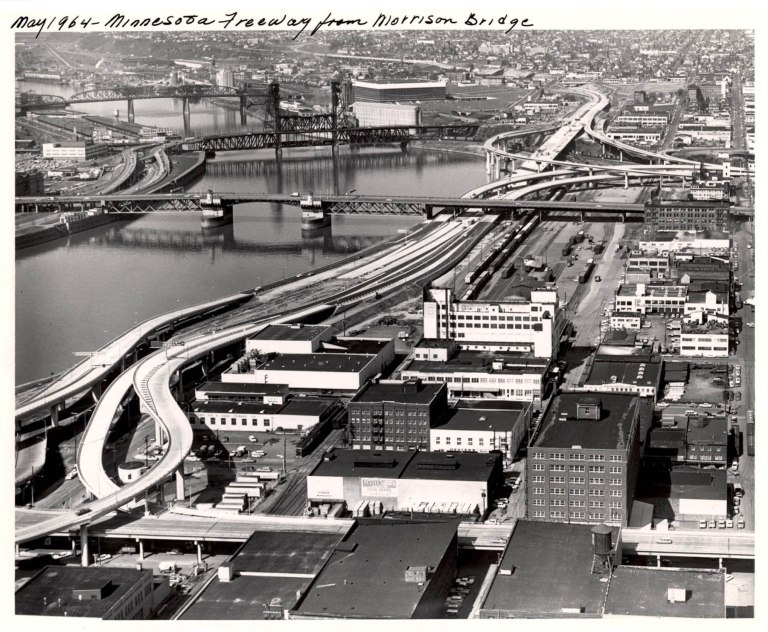I’m not real eager to identify a thesis for The Parks of Portland which, depending on your immediate plans, awaits your comprehension, [ click on the rose garden in the top left to fill your perceptions w/ glorious, distilled parks info ] mostly because no consistent argument unfolds—and the park scholarship refuses to intentionally let one—however I will outline what may be considered a foundational principle: colonialism does not end because we run out of land to colonize, instead it accelerates and reinforces itself in the places already taken, ensuring that the most capital can be squeezed out of the already bagged fruits, that the vast majority of people on one end can be juiced like oranges and the rinds can be gentrified and a renewed as accelerated cash flow for those who already have the vast majority of money. And on and on.
The military industrial complex was sold to this country as The American Dream and maybe it was vaguely real in Portland, Oregon, as community-oriented single-family homes churned the wheels of day-to-day life, if, of course, you didn’t live on Minnesota Avenue, which was stomped out as by Godzilla tracks to complete the glorious west-coast freeway that would take you from Vancouver to Tijuana as you played Bobby Darin on the stereo with the top down and your arm around your sweetheart, or where the Fremont Bridge made landfall in North Portland, or where the Fremont Bridge made landfall in Northwest Portland, or where it burrowed a wide trench where before downtown trickled further up the hill, a trench that further went on to cut out a vibrant single-family-home community to the south of downtown, the old Caruthers claim, or if you happened to live where the powers to be decided to put the coliseum, a quarter they decided to name after the roses that were ripped out of the front yards of houses which were themselves ripped up like heirloom rose bushes, which is where they also decided to have I-5 meet the Banfield Expressway, turning Sullivan’s Gulch into a dead river of metal, human flesh, and fast food debris, or on Williams or Vancouver Avenues when someone had the idea to build a massive hospital grounds where luckily there were only houses in the way. If you needed urgent care and lived in one of those houses you were double out of luck since it wasn’t until a decade after the house smash that they got around to building the hospital.
I guess, when you put it that way, when I put it this way, focusing on all that stomping out of said dream, which suddenly this line of thought has forced us to do, these freeways pulse through the imagination as in a 1950s cartoon, stacks a mile in the air pulsing with the ruby red blood cells of a poisoned circulation system.
Imagine a piece of land, imagine it’s in Portland, focus on it as time recedes, birds fly backwards and trees and plants shrink and shrivel back into the ground. Imagine if Asa Lovejoy had never filed Bill Overton’s land claim for the clearing of those trees and that grass—maybe even a goddamn wolf passed between this verdant life for all I know, it’s your imagination—that would have developed and torn down and redeveloped themselves by a beautiful collonading nurse log-jic, on the other end of the spectrum for the palimpsest of place, the collaborative document that is space, from gentrification, mallification—closer to urban decay, except western civilization never touched it, which is what urban decay represents, the rug pulling of western civilization, and in some cases trees sprout in former warehouses—but this different altogether, for decay is not feared outside of Jesus/Adam Smith-style European capitalism. Yet here we are, swimming in layers of said Jesus-faire meaning that indoctrinate us and reshape the land in order to do so more effectively. In Portland, Oregon venture capitalists buy up property from the struggling and California yuppies frolic through a new genre of chain story as Charlie Hales sings “America the Beautiful.” You can plant another tree, but you can’t go back to 1892 and rebuild the house you just demolished. The park symbolizes a respite from all this nonsense, the last bunker where anti-consumerist bohemian culture cannot be appropriated in the name of accelerated consumerism.
Imagine your piece of land, still well before the Corps of Discovery, somewhere between your understanding of the dawn of time and 1805, and pretend it’s the present day downtown block between Broadway and 6th/Morrison & Yamhill, watch as time moves forward, trees rise and fall, the river floods and drains, ad infinitum until, lo! a white man! and a tree in its prime is felled, and another, and another, until the grove becomes a clearing, and those former trees become their own kind of grove, but one through which air and animals do not pass freely for the once trees are stacked upon one another until not even light can penetrate the space. But, then replaced by brick, a building of its own kind—wait, is that the Portland Hotel standing so tall, proud, and inviting? Look at those suits and furs and hats and—did they just demolish that? It’s a parking lot now? And so yes, a new era, welcome to the world Pioneer Courthouse Square, “Portland’s Living Room,” an improvement on a parking lot, unless you’re looking for a place to put your car while you go to the Apple store.
So-called intellectual thought, a reason bent on categorizing, understanding, and moving on, is its own kind of imperialism, which is why I seek to avoid it, but, as the privileged son of America that I am, I have inherited the sensibilities of the colonizers. And so you have experienced yet another snake hypnotized by its own rattle and choking itself on its own tale [sic].


